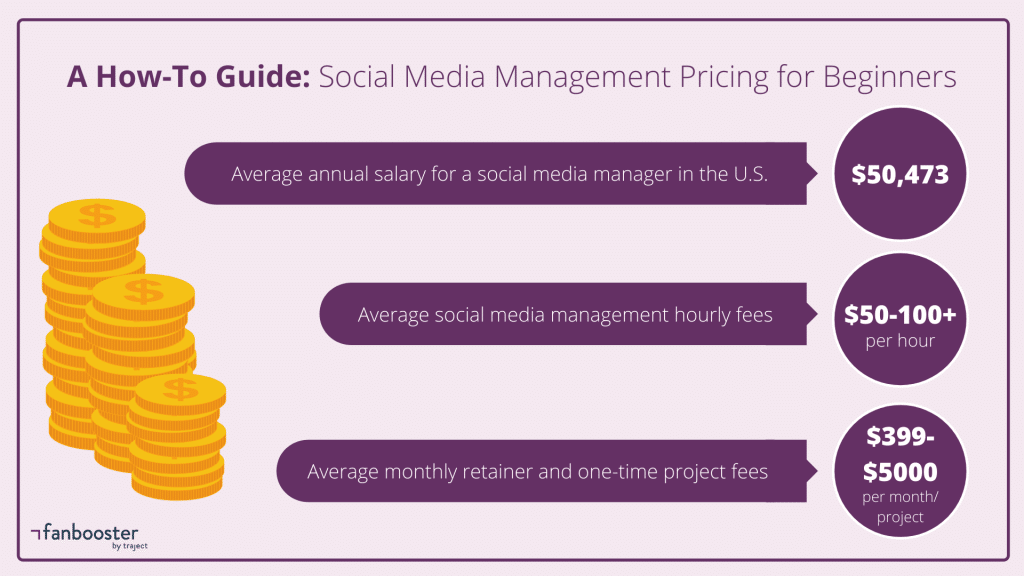When starting a social media agency, there’s plenty of preparation to be done. From creating repeatable processes to choosing software that helps you manage those processes across multiple platforms and clients, it pays to plan ahead.

Speaking of payment, social media management pricing is something many agencies and freelancers struggle with. This is especially true for those just starting out.
When work is slow and money is short, it’s easy to follow the “take whatever you can get” approach. However, for the sake of building a scalable business, you need to strike a balance between taking necessary work and knowing what your time is worth.
In calculating how much to charge for social media management and the various factors to consider, here’s what you’ll learn:
- How to account for experience when setting your rates
- Why your target audience might impact how much you charge
- Using client needs and goals to guide pricing models
- The importance of understanding what your time is worth
Table of Contents
How much should you charge for social media management?
Average hourly fees can range anywhere from $50-$100+ per hour. Alternatively, monthly retainer and one-time project fees can run upwards of $399-$5,000 a month per project.
Social media management pricing varies based on the client’s needs, their business model, your experience, and the breadth of services you offer. Conduct competitive research and consider factors specific to your social media management business to set your prices at a point that will sell.
Social media management pricing factors to consider
How much does it cost to have someone run your social media?
Pose that question to someone unfamiliar with the nuances of your work and you’ll either want to cringe or start hiking up your prices. Everyone has their own ideas of what managing social media looks like.
It’s kind of like writing. In the professional world, good writing is often undervalued because most people learn how to put a pen to paper and form a sentence at an early age. It’s not rocket science, right?
Social media is similar. Many people have experience with these channels from their personal accounts. They scroll through feeds and engage with brands every day.
But your job is more complicated than casual users think. You use your skills and expertise to turn a client’s social media spending into tangible results for their business.
Here are some social media management pricing factors to consider:
- Social media experience
- Your target audience
- Social media client needs and goals
- Social media agency time and resources
Social media experience
The average annual salary for a social media manager is $50,473. Converted to an hourly wage, you’re looking at $24 per hour for a standard 40-hour workweek.
For a full-time, in-house social media manager, this hourly rate doesn’t take into account the extra cost of their employee benefits (e.g., health insurance, retirement plans, and technology.). Since many companies choose to save money by outsourcing these services to agencies like yours, don’t hesitate to tack on a 20-30% profit margin for each job.
This can be a great starting place for gauging how much to charge for social media management. Research the annual salary for a social media manager, then consider your agency’s level of experience and work backward.
Additionally, audit rates for social media marketing on freelance marketplaces like Fiverr. How do the costs differ between beginners and Pro service sellers?

Source: Fiverr
Your target audience
Social media management pricing doesn’t work as a one-price-fits-all structure. Charging the same price across your client base doesn’t always make sense.
You have to factor in the types of businesses you cater to. For example, a nonprofit’s marketing budget is a lot smaller compared to a large software-as-a-service (SaaS) company.
The following represents rough estimates for social media marketing budget by industry, from low to high:
- Nonprofits: low
- Restaurants: low
- Independent service providers: low
- Small businesses: low to medium
- Travel: medium
- Publishing: medium
- Education: medium
- Sports/recreation: high
- Technology/SaaS: high
- Consumer retail: high
The size of a business (judged in terms of metrics like annual revenue) will definitely have an impact on the budget they have available for social media marketing services. Try to look at your pricing through the eyes of your potential clients.
Again, this is where a bit of competitive research will come in handy. Audit the prices of social media services and software tools that cater to your target market. Also, be mindful of pricing differences based on geography.
Social media client needs and goals
As HubSpot shares, there are three main agency pricing models worth considering when determining costs per client.
Potential social media agency pricing models include:
- Hourly-rate pricing model
- Fixed fee vs. project-based pricing model
- Value-based pricing model
The first two are fairly self-explanatory. You either charge by the hour or your charge by the project and/or recurring services.
With a value-based pricing model, both you and the client are incentivized by a specific end result. This is common among agencies that specialize in paid social, where the more leads or conversions you bring in, the more you get paid.
Time-tracking is a valuable practice to implement internally whether you charge by the hour or otherwise. Evaluating this data over time gives you a generalized idea of how long specific tasks will take.
As you expand your portfolio, associating a cost with a specific client request will start to become second nature. For example, say a business wants you to create 20 social media posts every month for two of their platforms.
You can average out the time it will take based on previous projects. Multiply that time by your hourly rate, tack on a margin fee, and sell it as a recurring project. Add-on services like community management or photography can command additional costs.
Social media agency time and resources
When you’re new to the social media agency game, there’s definitely a balance to be found in building up your client base while also making a living. Selling your first contract at $700 per month is an accomplishment but it’s not sustainable.
The lower your prices are, the more clients you have to bring on in order to make a profit. If you’re working within a well-staffed agency, that’s one thing — but if you’re a one-person show, the potential for burn-out is real.
Everything you do, whether it’s setting up a client’s content editorial workflow or writing a Facebook post, takes time. Figure out what that time is worth to you and charge your clients accordingly.
Final Thoughts: How to approach social media management pricing for beginners
Perfecting your social media management pricing is a process that evolves over time — and success isn’t measured by your ability to bamboozle clients out of their marketing budgets. It’s about standing by what your services are worth and proving their value with the quality of work you deliver.
As you grow, there are two major paths to take for scaling. On one hand, you can scale your business with more clients that will require additional costs to service them. On the other hand, you can increase your prices.
Ultimately, there are many options to consider as you find success.



